A visit to college football’s next recruiting pipeline: Europe
247Sports | American Football | 04/19/2019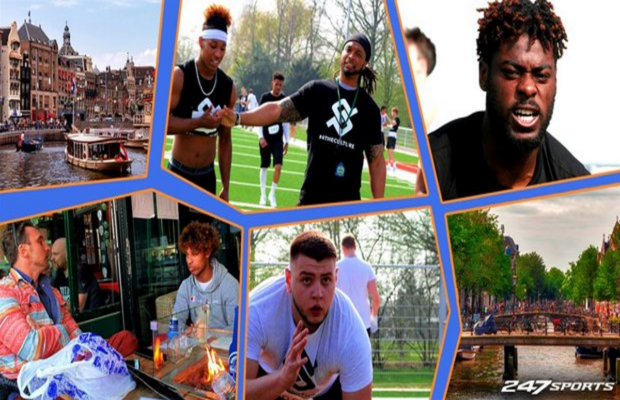
To drive a car in Amsterdam takes expertise. The roads are narrow and winding. They’re partitioned out for shared access with trolleys, loaded bike lanes and assertive pedestrians. It’s no place to be indecisive or ignorant.
Luckily for me, 19-year-old old aspiring football star Demierro Promes is manning the steering wheel. A native of the city, Promes deftly weaves through the pedestrians, bikes, one-way streets and construction workers while pointing out landmarks and detailing the demographics of the Netherlands. This is home for him. No roadmap needed.
Promes’ football career may take a little bit more guidance. To be clear, we’re talking American football here. Soccer didn’t hold the interest for Promes. Neither did handball or any of the other traditional sports of the Netherlands. He fell in love with football and he pursued it passionately. But he pursued it aimlessly.
A growing number of other college football hopefuls — and there are 200 kids from 10 different countries across Europe at a Saturday football camp I’m in Amsterdam to cover — have found their tour guide in Brandon Collier, a former UMass and professional defensive lineman. Collier has done a remarkable job of stimulating the American football talent pool in Europe and embracing the trade of shipping football talent across the Atlantic Ocean.
The results are tangible. The 247Sports database tracks every FBS signee in the country. According to that database, between 2010 and 2016, an average of 6.4 FBS signees per year came from outside of the country without playing a year of junior college or high school football in America. Between 2017 and 2019, those numbers shot up to 15 per year.
The phenomenon can’t be explained away by the rush of kickers from Down Under, either. These numbers excluded kickers and punters to account for the wave of Australians at the position. But before 2017, ‘international’ was limited almost exclusively to Canada and American Samoa. Twenty-one of the 45 international signees between 2010 and 2016 were Canadians. Another 19 were from American Samoa. Only two were from Europe.
In 2017 alone, two Europeans signed directly with FBS programs. That number grew to six in the 2018 cycle. In the 2019 cycle, Europeans accounted for over half of the 15 international non-kicker signees when eight prospects went directly from Europe to major college football. Among those eight, six of them signed with Power Five programs.
***
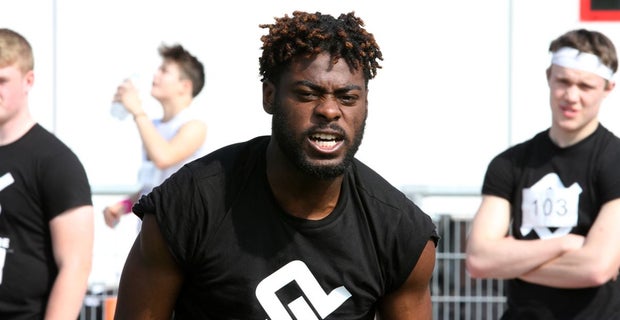
(Demierro Promes; Photo: Barton Simmons)
Love at first sight is easy. Long-term relationships are hard. Any European athlete seduced by football runs up against a problem quickly: What’s the end game? Where is this relationship going?
Promes was excelling in handball. He had that map in front of him. On his 16th birthday he went to Germany to play handball. He earned an opportunity to board with one of the major clubs in Germany. The infrastructure was there. The models for success and cultural support were in place. But his love affair with football had already begun.
“It was like the NFL for handball,” he said. “I almost agreed to that. My path to handball was already there. I chose football over that path.”
For all the flaws of the NCAA model, for all the amateurism hypocrisy, there is an aspirational element to college football that powers its incubation and health in America. Sports are tied to school. We take it for granted stateside. Play with your classmates at the lower levels with the promise that with enough talent, enough commitment and dedication, the next progression in your life – college – can be facilitated by football, or – depending on perspective – football can be facilitated by college.
Promes found the sport through his older cousin, a member of the Amsterdam Crusaders, the local club team. If all he had to aspire to was rising in the ranks of club football, perhaps he would have stayed the course with handball. Perhaps he would have shifted focus to soccer where his cousin Quincy Promes is making more than 3 million Euros per year while playing in La Liga for Sevilla FC. But through Collier, Promes found his map for football.
“It was a dream,” Promes said of football. “I wanted to play college football, of course. A year after that I started to meet [Collier] and he saw a lot of potential in me. He said, ‘When you are ready, you will get your first scholarship offer.’ That was intense. I made my dream my biggest goal, to get a scholarship at the highest level.”
As we sit together at breakfast, Promes holds offers from Temple and Towson. Towson was the first to pull the trigger after defensive line coach Konstantinos Kosmakos made the trip to Europe to watch Promes and others work out. Promes found out about that first offer while he was by himself on a train a few weeks after the workout.
“I was on the train and he texted me and he said ‘Hey buddy, I just want to congratulate you on your first offer. You have a full ride from Towson University.’ That was intense. It was crazy. I couldn’t yell because I was on the train and everybody would think I was crazy. I called my Mom and told her I had an offer from Towson. She started crying on the phone. I realized that I made a point in my life that’s difficult in my situation, to get an offer from a Division-1 school in America.”
***
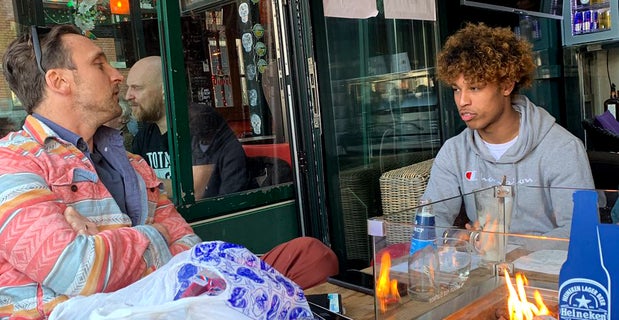
(Barton Simmons and Jairo Faverus; Photo: Courtesy Photo)
Sitting on a café patio, I tell a few local athletes that I want to eat something in Amsterdam I can’t get in America. They reply almost in unison that I need ‘kapsalan,’ translated to English, I’m told, as ‘barbershop’. It’s a layer of fries topped with shawarma meat, lettuce, and gouda cheese — it’s the type of dish that probably tastes best at 2 a.m.. I’m eating it at 2 in the afternoon, and it’s pretty good even then.
Over bites of kapsalan, Promes and two more Amsterdam locals, Mazen El Majdoubi and Jairo Faverus, talk excitedly about football. Faverus is one of the top prospects in Europe and someone that Collier and the other European coaches have high hopes for. He already has an offer from Georgia Tech and he’s got interest from the likes of Notre Dame. He landed that Georgia Tech offer when new head coach Geoff Collins made the trip to Europe during the winter evaluation period.
They are junkies for football. Where do I think DK Metcalf will get drafted? Why did we rank Jadon Haselwood over Garrett Wilson in the 2019 wide receiver rankings? What was Penn State’s whiteout against Ohio State like?
Even as we scrape clean the disposable metal kapsalan trays, the ‘barbershop’ talk continues. In fitting with barbershop tradition, it lands on some of the best players they’ve played against, the local legends. Every town has them. In my backyard, John Henderson and Al Wilson stories are trafficked regularly. For these guys, it’s Thomas Odukoya.
He’s a senior tight end for Eastern Michigan. He’s currently listed at 6-foot-6, 261 pounds and he started four games in 2018, his first year in the program after spending the previous two in junior college. Evidently, Odukoya was a lot to handle in Dutch club football.
There are others to look to as motivation. If you watched the popular HBO series “Hard Knocks” back in 2014, you were introduced to Geraldo Boldewijn, a player affectionately referred to by his Atlanta Falcons coaches and teammates as “Amsterdam”. Boldewijn got his NFL shot along with fellow Netherlands native Ricky Tjong-A-Tjoe out of Boise State. The two took a leap of faith, leaving the Netherlands for Boise, Idaho, where they played one year of American high school football before signing with the Broncos.
The constructs of a college football dream for Europeans has always looked like this. Find a junior college program or play your high school football in America. How else are college coaches supposed to find you? Aspire to play college football all you want, just don’t expect college coaches to come to you. You’d better go to them. Thanks in part to Collier’s efforts, that barrier of entry is starting to crumble.
“When I first started the goal was to bring recognition and credibility to the game in Europe,” said Collier. “As the game has evolved and I’ve seen a lot of talent, I made it a point that the kids didn’t need to go to high school in America to get recruited. A lot of kids, when I got here, were going to high school and paying a lot of money to get to America to play in high school. The ones that got scholarships when they went, they were good enough, they just didn’t have anyone put their name on the line for them.”
Collier’s response was to form Premier Players International. Through his network of coaches and industry contacts, he’s getting the right players in front of the right college coaches. He’s taking annual trips to America to hit the college summer camps during what he calls his Dreamchasers tour. It’s working.
Massive, 6-foot-9 German native Lorenz Metz is battling for a starting left tackle job at Cincinnati as a redshirt freshman. At Michigan a 6-foot-6 former mogul skier Julius Welschoff is running with the 2s and has been one of the emerging stars of the spring. Virginia signed three Europeans in the 2019 class alone, including quarterback Luke Wentz. Penn State’s top 15 class in 2019 featured German Joseph Appiah Darkwa.
“As far as the talent, it’s getting better and better. But people are dreaming more now,” Collier said. “Five years ago it was more of a fairytale dream to go to a college like Penn State and Notre Dame. But now it’s a goal and kids believe they can play at Alabama, Clemson and Ohio State and Penn State’s of the world. Kids really believe now five years later.”
Further proving his point, Collier is recently coming off of a trip to America where he visited several schools interested in European talent. Among them were defending national champion Clemson and defending runner-up Alabama. Another playoff team, Notre Dame, took it a step further. Defensive line coach Mike Elston visited Germany in January and accepted a commitment from 2020 defensive lineman Alexander Ehrensberger. Penn State’s entire staff is coming to Germany in late April spending precious days of the evaluation period to see what Europe has to offer.
New UMass head coach Walt Bell wasted no time in tapping into European talent. Following the Amsterdam camp, four prospects reported offers from UMass and Bell has leaned into the movement as an opportunity to be first to the party.
“I think for us at UMass it’s obviously an entire continent of people, great population density and not the entire world recruiting there,” Bell told 247Sports. “All 130-plus FBS schools and every FCS school in America recruits Atlanta. From a population density standpoint, you’ve got an incredible amount of bodies and even though football is just now growing, there’s great athletic ability there and not the whole world recruiting it.”
Bell also points to the many high-academic prospects coming out of the region as an important element at a program like UMass that wants those profiles. That is something that Ivy League programs have been drawn to as well.
Another element at play is the rising disparity between college football talent in the Southeast compared to the Midwest and Northeast. Just look at the developing recruiting footprint of Michigan, Ohio State and Penn State: All three have made extreme national pushes well outside the traditional Big Ten recruiting footprint in recent years. An international extension of that only makes sense given all of the sharks that you have to compete with in hotbeds like Florida, Georgia and Texas.
***
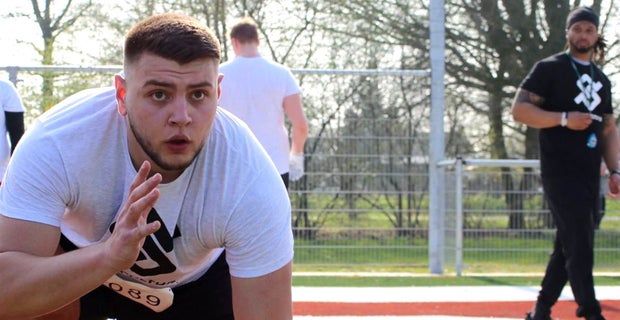
(Liridon Mujezinovic; Photo: Barton Simmons)
On Saturday morning, Promes leads me to the field where our combine will take place. I’m told it’s the only field in Amsterdam lined as a football field. It’s the home of the Amsterdam Crusaders, the local club team. Located in the back corner of an expansive sports park, we walk past what feels like four or five soccer fields before reaching our destination.
The Crusaders don’t play in a stadium. There are no bleachers. There’s a small fieldhouse and a turf field surrounded by a chain-link fence lined with the kind of sponsor signage you may see on a little league baseball field. This is big-time football in the Netherlands.
The camp is a joy. For the Europeans, this is their chance to be a part of the football conversation, a chance for them to engage. The talent is raw, the spectrum of skill is broad. There are Power Five-level college football players there. But in many cases, you have to be open-minded as an evaluator to find them. Inexperience abounds, and a different athletic culture produces different athletes in Europe:
* Marcel Dabo, a skill athlete from France, posts a fantastic standing broad jump number of 10-feet-8 inches and I learn that he has extensive background in parkour, perhaps lending to that explosiveness.
* Joe Cassidy is one of the more polished defensive backs despite a background in gymnastics, diving and trampoline moreso than football.
* Marko Ilic is a 6-3.5, 200-pound linebacker from Denmark that spent much of his athletic lifespan as a goalie in soccer and is relegated to cornerback by necessity for his club team. Like many at the combine, he’s older at 21 years old and fully qualified for a four-year institution.
* There’s a massive 6-foot-8, 282-pound offensive lineman on hand named Liridon Mujezinovic. He already holds a Cincinnati offer and this camp nets him a UMass offer as well. Raw as can be but straight out of central casting for Game of Thrones, Mujezinovic is barely a year into his football career after a friend ran into him in the weight room and suggested he give the sport a try. He played 14 years of soccer before he found the gridiron.
“It was always a dream living in the states,” Mujezinovic told me. “And now I’m going to the states and playing football, so it’s all perfect. It would be insane if I had started playing four years ago. I don’t know where I’d be at the moment. If I hadn’t met the guy at the gym, I wouldn’t be here. So I’m lucky.”
* Ehrensberger, the Notre Dame 2020 commit is on hand. He’s one week away from the start of his club season so he passes on the workouts but from a physical standpoint, he’d stick out at any camp in America. He’s 6-foot-7, 240 pounds and he looks like a coach or college kid returning home to help the youngsters. Grounded athletically with an extensive tennis and soccer background, he fell in love with the sport of football while in America on an exchange program in 10th grade. It gave him something no other sport had provided.
“I loved the complexity of the game and the multiple sights, different athletes coming together,” Ehrensberger said. “In soccer you need tall and fast. In football you need everything. It’s so interesting. You get to know so many different guys.”
The camp winds down but nobody wants to leave. There is a literal line of athletes waiting to talk to me after camp. No one is upset about their star ranking or anxious about their testing results; they just want to talk ball. About an hour after the end of camp, I’m still fielding questions from the athletes about what they need to work on to improve and what their game is missing. If there weren’t trains to catch and rides departing, it might have been a few hours more.
***
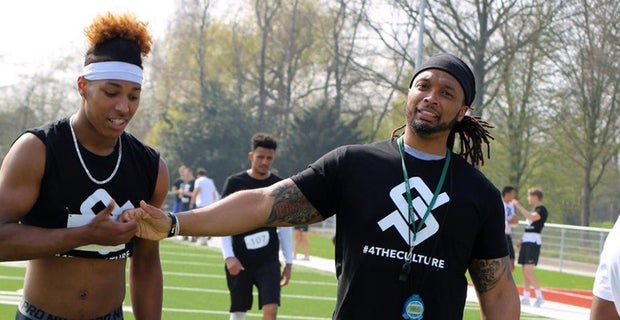
(Jairo Faverus, left, and Brandon Collier; Photo: Barton Simmons)
We settle in and recap the day. Promes was one of the most athletic prospects there, running a 4.56 40 with a standing broad jump of just under 10 feet. He’s got some stiffness, but his size, versatility and straight-line explosiveness will make him an intriguing and tempting prospect when he works out for college coaches later this summer. Honig is deliberate and methodical at quarterback but has a massive arm and great athleticism considering his size (6-5.5/230) at mid-4.8 in the 40.
There’s an isolation to being an aspiring football star in Europe. Honig and Promes talk about the commitment and sacrifice it takes to go against the grain for a sport that is more continental curiosity than national obsession. At the very least, football prospects in Europe self-select as a group willing to embrace some lonely work. The crowds aren’t big. The reassurances aren’t much. But the goals are the same. And the path to reach them is clearing.
An hour or so into our meal, a waitress engages Promes. He speaks five languages, four of them fluently. At this meal alone, he’s had cause to use all four, conversing in German with Honig, English with me, Dutch with other patrons and now he’s speaking Surinamese with our server. When they’re done, I expect an update on our food. Instead, we’re all met with a surprise.
“She wanted to know if I was the American football player,” Promes said with a grin, surprised and pleased about his first celebrity sighting.
Word is spreading.
Read the original article in 247 Sports.
HEADLINES
-
Advertisement
-
Advertisement